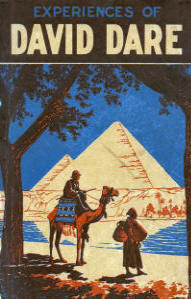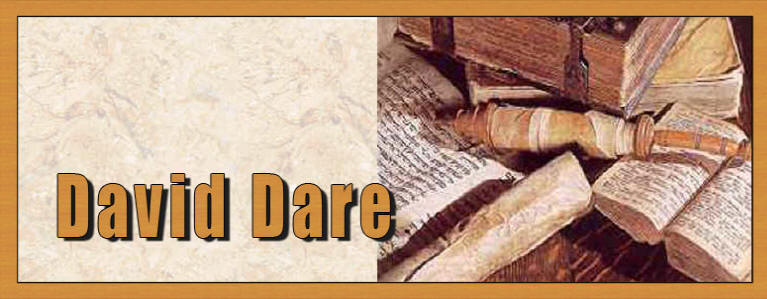|
CHAPTER 4HOW TO DISPROVE THE BIBLEDAVID DARE’S STATEMENT that he could tell unbelievers how to disprove the Bible, startled some of his listeners. A few Christians were shocked and said so. Unbelievers were amazed. Mr. Emerson arose, and spoke: “Do you mean to tell us that you admit the Bible can be disproved?” “On the contrary, I do not believe any part of the Bible can be disproved,” smiled Mr. Dare. “But you said you would show us how to disprove it,” insisted Mr. Emerson. “And I will.” “Your statements sound contradictory, but let’s hear what you have to say.” “God Himself has not only dared you to disprove His predictions, but has also taken the pains to tell you how. Tyre has continued a daily defiance to every unbeliever. ‘Thou shalt be built no more: for I the Lord have spoken it,’ says the prophecy. Read it for yourself in Ezekiel 26:14. The reason it cannot be rebuilt is here given. Here is a test that God has set for the boasting unbeliever — the simple one of rebuilding a city. To do that one thing would disprove the Bible. “And this is not asking an unheard-of thing. Many cities in the past have been rebuilt. Even Rome rose again after Nero watched it burn. “That a city can be built in a surprisingly short time, by a few determined men, was proved recently when a marsh was transformed by one man into the modern city of Longview, Washington, in two years. I visited the city personally, and marvelled at the amazing feat. [editor's note: The modern city of Tyre, Lebanon is not on the same site but is beside it.] “A dollar each from the unbelievers in England and America would be sufficient to rebuild Tyre, and thus blast for ever the reputation of the Bible as a truth-telling book. Why not form an infidel colony on the site of old Tyre, go into the fishing business in a modern manner, and there, in defiance of prophecy, dare to answer God’s challenge, ‘Thou shalt be built no more; for I the Lord have spoken it?’ “The site is habitable: ten million gallons of water daily gush from the springs, and fertile fields stretch clear to the distant mountains. “Since there are millions of determined doubters who write numberless books to disprove the Bible, how did any prophet have the breath-taking daring to utter such a defiant prophecy? For two thousand years no sceptic has dared say the prediction is untrue. “In fact, Volney, the French sceptic, tells of visiting this spot and observing fishermen drying their nets on the rocks, just as the prophet said they would.” (“Travels,” Vol. 2, page 212). “Every year, every day, every minute that Tyre has remained in utter ruin it has disproved the emphatic declaration of sceptics that Bible predictions are vague or were made after the events which they foretell took place. “ ‘A good guess,’ you say. But that is not a sufficient answer. It is especially lame in view of the fact that no person outside of the Bible ever made a solitary correct forecast covering hundreds of years concerning any city on earth. How is it that only Bible writers are able to ‘guess’ with perfect accuracy two thousand years into the future?” Mr. Emerson stood up to reply: “It would be natural for a writer, looking upon a ruined city, to assume, hence to predict, that it would never again be inhabited.” “Such an assumption, however natural,” replied Mr. Dare, “would have plunged the prophet immediately into serious difficulty. “To illustrate: Ezekiel turned his attention to Tyre’s still more ancient sister city only thirty miles distant. For centuries it had been declining in power, while Tyre was still glorying in the splendour of its heyday. Accepting your view of the day of Ezekiel adds strength to our contention, for while Sidon was still in a state of decay it was taken by Artaxerxes Ochus, king of Persia, in 351 B. C. , and destroyed! “Now, according to your theory, Mr. Emerson, Ezekiel was written still later, at least after Alexander’s time. So if the prophet were judging by appearances in 330 B. C. as you claim he did judge, he would have pronounced complete oblivion as the inevitable fate of Sidon, for nothing seemed more certain than its utter eradication. But Sidon still remains, even now possessing ten thousand population. Let us read the words of the prophet Ezekiel, chapter 28:20-23: “ ‘The word of Jehovah came unto me, saying, Son of man, set thy face toward Sidon, and prophesy against it, and say, Thus saith the Lord Jehovah: Behold, I am against thee, O Sidon. . . . For I will send pestilence into her, and blood into her streets; and the wounded shall fall in the midst of her, with the sword upon her on every side.’ “Observe that the judgment on Sidon was not utter extinction like that on Tyre, but only blood in her streets, wounded in her midst, the sword on every side. In spite of the fact that no other city on earth, with the possible exception of Jerusalem, has had so much suffering, has been so often destroyed and rebuilt, Sidon has continued an uninterrupted existence down to the present minute. “Now, suppose Ezekiel had said that both Tyre and Sidon were to be destroyed and were to be built no more, then every one of the ten thousand inhabitants of Sidon would be a living proof of the falsity of the prophecy. “Suppose, further, that the prophet had said Tyre was to live, but would undergo great suffering, while Sidon was to be utterly destroyed and never rebuilt; how derisive the sceptic would rightly be of the Bible claim to predictive accuracy! “How did it happen that the prophet was exactly right in both cases? How is it that the city that never has been rebuilt is the city of which this fact was foretold, and that the city which has continued to exist with age-long suffering is that which the prophet foresaw would continue in existence to the end of time? “When you have explained this satisfactorily, you have a still harder question to answer. Sidon, like many other ancient cities, might have sunk into insignificance, so that in its utter defencelessness it could have offered no resistance to even a feeble enemy, and would have tempted no one’s cupidity. How did Ezekiel know that, in spite of many terrible experiences, it would continue a place of strength which, age after age, would be fought for, and passed on, wet with blood, from one conqueror to another?” Mr. Emerson replied: “These two cities were well known and powerful, but at the time of the predictions there were indications of the fate that was to befall them. The predictions turn out to be fairly accurate, but you cannot establish your thesis that the Bible is true on so slim a basis.” “Certainly not, and I do not claim to,” responded Mr. Dare. “A prophecy to meet any test you desire to make can easily be produced. You claim that Tyre and Sidon had already, to some extent, indicated in themselves their fate. We’ll take a city of which this cannot possibly be said. “Out of a score of such forecasts, notice two sentences about Ashkelon, a city hardly less famous than the two we have just considered. Ashkelon shall be ‘a desolation,’ (Zephaniah 2:4); ‘Ashkelon shall not be inhabited.’ Zechariah 9:5. “This city was founded in 1800 B. C. and was in the height of its power about the time of Christ. So you cannot claim that at the time of the prediction its impending fate was apparent to the observer. But how about it now? “Let me quote from the fourteenth edition of the Encyclopaedia Britannica, Volume 2, page 544: ‘Now a desolate site on the seacoast twelve miles north of Gaza. . . .Protruding from this sand-swept terrain, shattered columns and the remnants of ruined buildings and broken walls bear ample testimony to a past magnificence. . . . The country around it is fertile. Vines, olives, and a variety of fruit trees flourish.’ “Observe that this world-recognized authority, in describing the present condition of Ashkelon, uses the very word of the prophet — ‘desolate.’ The prophet saw twenty-five hundred years ago what the historian now sees, and both use the same word to describe the final condition of that city. But to quote further from the same authority: “Ashkelon ‘was the birthplace of Herod the Great, who adorned it with fine buildings. During the Roman period it was a noted centre of Hellenic scholarship. It became also the seat of a bishopric. From 104 B. C. for four and a half centuries it was an oppidum liberum of the Roman Empire.’ “Thus on any theory of Biblical composition the city grew in importance for hundreds of years after the prediction. “In A. D. 636 it passed to the Arabs. During the Crusades it was the key to south-west Palestine. Baldwin III captured it after six months’ siege in 1153. It was thus still a very powerful city fifteen centuries after the prophet foretold its destruction. During the next hundred years its history was a bloody one. Finally, in A. D. 1270, Sultan Beibars destroyed its fortifications and blocked its harbour with stones. Thus for 660 years the lofty towers of Ashkelon have lain scattered on the ground, giving a picture of desolation; and the ruins within its walls do not shelter a solitary human being. “But suppose Ashkelon were, like Sidon, a flourishing city, or suppose the predictions had been transposed, how eagerly would unbelievers seize upon the fact! And if it were a fact, it should be used. The Bible says: ‘Never disdain prophetic revelations, but test them all.’ 1 Thessalonians 5:20, 21, Moffat’s translation. “You do the disdaining, but not the testing. Here are three cities. the prophets foretold their condition exactly as they are today. However you choose to account for it, the fact remains that these prophecies are true.” Mr. Emerson took this occasion to speak: “You have picked out three cities. Surely, if the Lord is the author of predictions, He tells us something about whole nations as well. And the predictions should be given at a time when it would seem impossible for the forecast to come true, and should reach to the present time.” “Your suggestions are reasonable. Out of several countries which meet your test, we will select the oldest country in the world — Egypt.” |


